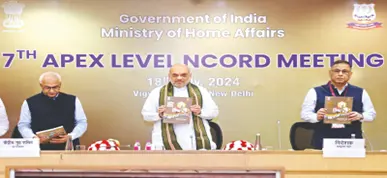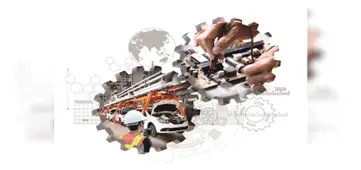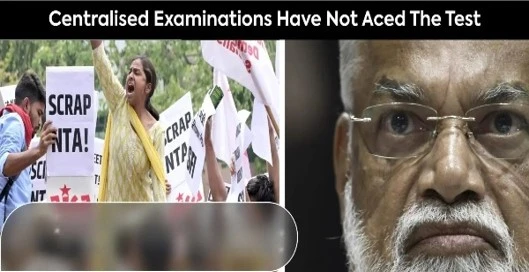Tuesday, 23rd July 2024
ICJ’s Observation about Israel’s Occupation of West Bank
Why in the News?
- The International Court of Justice (ICJ) recently declared that Israel's occupation of the West Bank and East Jerusalem violates international law.
- The ICJ emphasised that Israel's presence in these Palestinian territories should cease as soon as possible.
- Israel has occupied these areas since the Six-Day War in 1967, prior to which they were under Jordanian control.
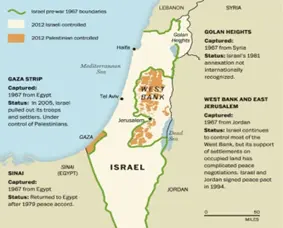
International Court of Justice (ICJ):
- About:
- The ICJ is the principal judicial organ of the United Nations (UN).
- It was established in June 1945 by the Charter of the United Nations and began its work in April 1946.
- The seat of the Court is at the Peace Palace in The Hague (Netherlands).
- It is the only one of the six principal organs of the UN that is not located in New York City.
- English and French are the ICJ’s official languages.
- Role:
- To settle, in accordance with international law, legal disputes submitted to it by States.
- To give advisory opinions on legal questions referred to it by authorised United Nations organs and specialised agencies.
- Judges:
- The ICJ has 15 judges who are elected to nine-year terms by the UN General Assembly and Security Council, which vote simultaneously but separately.
- The president and vice-president of the court are elected for three-year terms by secret ballot. Judges are eligible for re-election.
- Members and Jurisdiction:
- All members of the UN are automatically parties to the ICJ statute. However, this does not automatically give the ICJ jurisdiction over disputes involving them.
- The ICJ gets jurisdiction only if both parties consent to it.
- The judgement of the ICJ is final and technically binding on the parties to a case.
- There is no provision for appeal. Judgments can at most be subject to interpretation or, upon the discovery of a new fact, revision.
- The ICJ has no way to ensure compliance with its orders; its authority is derived from the willingness of countries to abide by them.
Meaning of Occupation in International Law:
- The most widely accepted definition of occupation comes from Article 42 of the Hague Convention (IV) respecting the Laws and Customs of War on Land and its annex, 1907.
- It states that a "territory is considered occupied when it is actually placed under the authority of the hostile army."
- An occupation must be temporary and cannot involve transferring sovereignty to the occupying power.
- Once a territory is seized, the occupying power has obligations towards the inhabitants, as outlined in the 1907 Hague regulations and the Fourth Geneva Convention of 1949.
- These obligations include providing food and medical care to the population and prohibit transferring civilian populations and using or threatening force.
ICJ’s Opinion on Israel’s Occupation:
- Background:
- In December 2022, the UN General Assembly adopted a resolution seeking the ICJ’s advisory opinion on the “legal consequences arising from the policies and practices of Israel in the Occupied Palestinian Territory, including East Jerusalem."
- This request came well before Israel’s assault on Gaza following the Hamas attacks of October 7, 2023.
- The recent opinion of ICJ came against this backdrop. It should be noted that the ICJ’s opinion is not binding or enforceable.
Opinion Rendered by the ICJ:
- On Prolonged Occupation:
- International law does not set a specific time limit for an occupation, so the legal status of an occupation cannot be determined by its duration.
- The legality of an occupation is affected by the occupying power's "policies and practices and the manner in which they are implemented and applied on the ground."
- On Settlement Policy:
- The ICJ examined Israel's settlement policy in the West Bank and East Jerusalem since 1967 and found it violated international law.
- The court highlighted several issues:
- The settlement policy and military measures have forced Palestinians to leave occupied territories, violating Article 49 of the Fourth Geneva Convention.
- The policy breaches Articles 46, 52, and 55 of the Hague regulations by expanding settlements through land confiscation, thus failing to protect private property, civilian objects, and the natural environment.
- The policy violates Article 43 of the Hague regulations, as Israel applies its own laws to settlements and East Jerusalem, disregarding existing local laws.
- The policy led to violence by Israeli settlers and security forces against Palestinians, which Israel failed to prevent or punish, creating a coercive environment against Palestinians.
- On Annexation of Palestinian Territories:
- The ICJ stated that annexation is the permanent control over an occupied territory.
- It found that Israel's policies and practices in the West Bank and East Jerusalem are intended to be indefinite and create irreversible effects.
- These policies include the maintenance and expansion of settlements, exploitation of Palestinian natural resources, proclaiming Jerusalem as Israel's capital, and applying Israeli domestic law in East Jerusalem and the West Bank.
- The ICJ concluded that these actions violate the prohibition of the use of force in international relations, affecting the legality of Israel's occupation.
- On Discriminatory Legislation and Measures:
- The court found that Israel's legislation in the occupied territories results in systemic discrimination against Palestinians based on race, religion, or ethnic origin.
- This violates the International Covenants on Economic, Social, and Cultural Rights 1954 and Civil and Political Rights 1954, as well as the International Convention on the Elimination of All Forms of Racial Discrimination 1965 (ICERD).
- The court observed that Israel's policies maintain near-complete separation between settlers and Palestinians, violating Article 3 of ICERD, which obligates the eradication of apartheid and racial segregation practices.
- On Self-Determination:
- The ICJ determined that Israel's occupation has violated Palestinians' right to self-determination.
- It noted that the prolonged deprivation of this right undermines Palestinians' ability to exercise it in the future, contravening fundamental principles of international law.
- On Future Course of Action:
- The ICJ stated that Israel is under the obligation to:
- Immediately end its illegal occupation.
- Cease new settlement activities and evacuate settlers from the occupied territories.
- Make reparation to all affected people for the damage caused.
- The court said that other states should not recognize the occupied territories as part of Israel and refrain from providing aid or assistance to Israel in maintaining this occupation.
- The ICJ stated that Israel is under the obligation to:
Source: IE
Female Employment to Counter Unemployment
Why in the news?
- The India Employment Report (IER) 2024 highlighted an increase in the unemployment rate from a little over 2% in 2000 and 2012 to 5.8% in 2019.
- Although the unemployment rate slightly reduced to 4.1% in 2022, time-related underemployment remained high at 7.5%.
- Enhancing the female labour force participation rate (LFPR) could significantly improve overall family income and welfare, especially in rural India.
Unemployment Trends and Labour Force Participation:
- The LFPR fell sharply from 61.6% in 2000 to 49.8% in 2018 but partially recovered to 55.2% by 2022. However, this recovery masks significant gender disparities.
- Female Labour Force Participation:
- Rural India: Increased from 24.6% in 2018 to 36.6% in 2022.
- Urban India: Rose modestly by around 3.5% from 20.4% in 2018.
- Male Labour Force Participation:
- Showed only marginal improvement in rural areas and stagnated in urban settings.
- Despite the positive trend, female LFPR in India remains low compared to the global average of 53.4% in 2019 and has declined from 38.9% in 2000 to 23.3% in 2018.
Gendered Employment Choices and Challenges:
- Unpaid Family Labor and Gender Imbalance
- In 2022, 36.5% of women worked as unpaid family labourers compared to just 9.3% of men.
- This disparity is more pronounced in rural areas: 31.4% for women vs. 8.1% for men.
- Unpaid family labour does not contribute to formal economic metrics or provide financial independence, limiting women’s economic mobility and perpetuating dependency and undervaluation of their work.
- Preference for Traditional Occupations:
- Women often opt for traditional, home-based occupations due to their flexibility and compatibility with household responsibilities. These roles, however, typically offer lower income.
- The lack of alternative opportunities forces many women to remain in these traditional roles, further aggravated by limited access to capital and restrictive social norms in urban areas.
Emerging Trends in Female Labour Force Participation:
- Positive Shifts:
- From 2018 to 2022, female LFPR in rural India increased from 24.6% to 36.6%.
- This rise indicates a growing recognition of women’s potential as active contributors to the economy.
- Challenges:
- Overall female LFPR remains low compared to the global average and has historically declined.
- The rise in rural LFPR could be attributed to targeted employment schemes, improvements in local economic conditions, and increased awareness of women's rights and opportunities.
Case Studies and Field Observations:
- Upper Gangetic Plains of Uttarakhand and UP
- The type of irrigation infrastructure significantly influenced women's employment opportunities and decision-making abilities.
- Women’s involvement in agricultural work increased with the expansion of less dominant irrigation sources like canal irrigation, enhancing their decision-making capabilities and economic standing.
- West Bengal's Minor Irrigation Projects and Kolkata Slums Study
- Water resource development had a transformative impact on women's employment and family welfare.
- Women initiated various economic activities, significantly improving their economic status and reducing migration.
- Women’s workforce participation proved critical during the COVID-19 pandemic, enhancing economic resilience and reducing vulnerability.
Strategies for Female Employment Generation:
- Empowering Self-Help Groups (SHGs)
- Collectivising women under SHGs and federations can provide training in new skills and link women directly to markets for better economic returns.
- Example: Kutch Mahila Vikas Sangathan (KMVS) supports women in traditional occupations through such collectivisation.
- Encouraging Women to Enter Male-Dominated Workspaces
- Empowering women through employment outside their homes can enhance their agency and meet strategic gender needs.
- Generating new employment opportunities in underexplored areas is essential.
- Formal Employment Opportunities and Female Entrepreneurship:
- Developing new job opportunities catering to women's skills and preferences, expanding vocational training programs, and supporting sectors with high potential for female employment.
- Providing women with access to capital, training, and mentorship to help them start and grow their businesses.
- Initiatives like microfinance programs and business development support can empower women to become entrepreneurs.
Conclusion
The rising female LFPR in India, particularly in rural areas, presents a promising avenue for addressing unemployment and underemployment. By focusing on creating appropriate employment opportunities, improving working conditions, and empowering women through collectivisation and market access are crucialIndia can enhance overall employment, family income, and women's position in society, driving forward both economic and social development.
|
Prelims: Q:1 Which of the following gives ‘Global Gender Gap Index’ ranking to the countries of the world? (2017)
Ans: (A)
Mains: Q1 Though women in post-independent India have excelled in various fields, the social attitude towards women and the feminist movement has been patriarchal.” Apart from women’s education and women empowerment schemes, what interventions can help change this milieu? (2021) Q2 Women empowerment in India needs gender budgeting. What are the requirements and status of gender budgeting in the Indian context? (2016) |
Source: TH
Govt. Considers Rs 50,000 Crore Scheme for agriculture
Why in the News?
- The Central Government is contemplating a new scheme with an outlay of Rs 50,000 crore to encourage states to implement agricultural reforms.
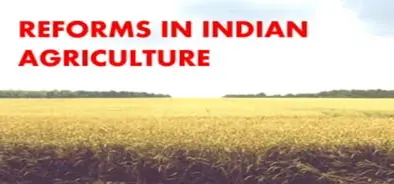
Problems Faced by the Agriculture Sector in India:
- Access to Credit & Finance:
- Small farmers find it challenging to secure affordable loans, which limits their ability to purchase modern equipment, quality seeds, and fertilisers, thus affecting their productivity.
- Small Landholdings:
- Many farmers own small, fragmented plots, making it difficult to utilise modern farming techniques and reducing overall productivity.
- Outdated Farming Practices:
- A significant number of farmers still rely on traditional methods due to limited information and resistance to change, impeding the adoption of advanced techniques.
- Water Scarcity & Irrigation:
- Agriculture's reliance on monsoon rains makes it susceptible to droughts and inconsistent rainfall.
- Access to irrigation and effective water management is vital, particularly in regions with limited water resources.
- Soil Degradation & Erosion:
- The use of chemical fertilisers and pesticides, combined with poor land use practices, degrades soil quality, leading to reduced fertility and productivity.
- Inadequate Agricultural Infrastructure:
- The lack of storage facilities, cold chains, good rural roads, and market access results in post-harvest losses and higher production costs, limiting farmers' ability to secure fair prices.
- Market Volatility & Price Fluctuations:
- Farmers experience unstable prices due to weak market links and insufficient price information, making them vulnerable to exploitation and uncertain returns.
- Climate Change & Natural Disasters:
- Unpredictable weather, climate change, and natural disasters such as floods and droughts cause crop losses and increase risks for farmers.
- Limited Access to Technology & Research:
- Farmers have limited access to modern technologies and research, which hinders the adoption of innovative practices. They require better knowledge, training, and affordable technology solutions.
- Lack of Farmers’ Empowerment:
- Farmers often lack representation in policymaking, leading to initiatives that may not effectively address their specific challenges.
About NITI Aayog’s Proposal
- Proposal by NITI Aayog: Background
- Nearly three years after repealing its three farm laws in November 2021, the Union government is planning a new scheme with a budget of Rs 50,000 crore to motivate states to implement agricultural reforms.
- This initiative will provide central funding for states to enact reforms in agriculture marketing, contract farming, and land leasing.
- NITI Aayog officials presented the idea for this scheme to the Prime Minister’s Office.
- The presentation, titled “India’s Amrit Kaal: Mobilising the nation to sustain fast growth,” addressed various economic sectors.
- Officials from the Ministry of Agriculture and NITI Aayog are discussing this scheme as part of their broader efforts to implement significant farm sector reforms during India’s 'Amrit Kaal,' spanning from 2022 to 2047.
- Various Reform Measures under Consideration
- Other proposed reforms include passing the long-pending Seed Bill and increasing public investment in agriculture to 5% of Agriculture GVA (Gross Value Addition).
- This proposal revisits an idea suggested by the 15th Finance Commission in its 2020-21 report, which recommended performance-based incentives for states that implement agricultural reforms.
- States could receive financial rewards if they adopt the Model Agricultural Produce and Livestock Marketing Act (2017), the Model Agricultural Produce and Livestock Contract Farming Act (2018), and the Model Agricultural Land Leasing Act (2016).
- The 15th Finance Commission believed these reforms were essential to liberalise agricultural markets, promote competition, and attract private sector investment.
- However, after the central government passed the three farm laws in 2020, the Commission revised its recommendations.
- The Commission’s 2021-26 report emphasised four key areas for performance-based incentives:
- Land lease reforms
- Sustainable water uses in agriculture
- Export promotion
- Contributing to Atmanirbhar Bharat.
- It had proposed Rs 45,000 crore for states undertaking agricultural reforms during this period.
|
UPSC Civil Services Examination, Previous Year Question (PYQ) Prelims Q.1 In the context of India’s preparation for Climate-Smart Agriculture, consider the following statements: (2021)
Which of the statements given above are correct?
Ans: (d)
Q.2 With reference to the provisions made under the National Food Security Act, 2013, consider the following statements: (2018)
Which of the statements given above is/are correct?
Ans: (b)
Mains Q.1 In what way could replacement of price subsidy with Direct Benefit Transfer (DBT) change the scenario of subsidies in India? Discuss. (2015) |
Source: IE
Patent Ecosystem in India
Why in the news?
- For the first time, domestic patent applications in FY24 have surpassed those from foreign applicants, largely due to a surge in applications in fields like computer science, IT, pharmaceuticals, and chemicals.

- However, foreign entities still hold a significant portion of the patents awarded in India, accounting for nearly two-thirds of all approved applications.
What is a Patent?
- Definition: A patent is an exclusive right granted by the government for an invention, which must be novel, non-obvious, useful, and patentable as per national law.
- Purpose: It provides a technological solution to a technical challenge.
- Duration: Legal protection is granted for 20 years from the date of filing.
- Regulation: The Indian Patents Act 1970 specifies what is patentable. The Controller General of Patents, Designs & Trademarks (CGPDTM) oversees the patent system in India.
Domestic Patent Applications in India:
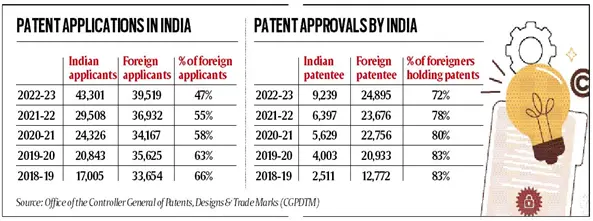
- Growth:
- The share of applications from residents increased from 34% in FY19 to 53% in FY24.
- Challenges:
- Despite the rise in applications, approvals lag due to the quality of applications and the patent ecosystem.
- India has fewer patent examiners (597) compared to Germany (821) and the US (8,000). There are also procedural delays.
Foreign Patents in India:
- High Approval Rate:
- Patent approvals are skewed in favour of foreign entities, with global IT giants leading. Patents for non-resident entities stood at 76.46% in 2022.
- Comparison:
- The approval rate for foreign patents in India is among the highest globally, with China at 12.87%.
- Reasons:
- The gap reflects inefficiencies in India’s R&D capabilities and lower private investments.
- The Patent Cooperation Treaty (PCT) facilitates foreign entities to file patents in multiple countries simultaneously.
India’s R&D Spending and its Impact:
- Stagnation:
- India’s R&D spending as a percentage of GDP has declined to 0.65% in 2022 from 0.83% in 2008, below the global average of 2.62%.
- Impact:
- Low R&D spending results in reliance on imported machinery and foreign technicians.
- India faces a trade deficit with 8 out of its top 10 trade partners, with imports from China alone crossing $100 billion in FY24.
Government Initiatives to Boost Intellectual Property (IP) Ecosystem:
- Scheme for Startups Intellectual Property Protection (SIPP): Promotes and mentors new technologies among startups, providing access to high-quality IP services.
- National Intellectual Property Rights (IPR) Policy: Launched in 2016, it aims to foster innovation and creativity in India.
- Draft Model Guidelines for Academic Institutions: Establishes an efficient process for ownership control, assignment of IP rights, and revenue sharing.
- National Intellectual Property Awareness Mission (NIPAM): Aims to educate 1 million students on intellectual property and its rights.
Conclusion:
The patent ecosystem in India is evolving, with domestic applications increasing. However, challenges remain in terms of approvals and R&D spending. Government initiatives aim to strengthen the IP ecosystem, fostering innovation and growth.
|
UPSC Civil Services Examination, Previous Year Question (PYQ) Prelims: Q1. What is/are the recent policy initiative(s)of Government of India to promote the growth of the manufacturing sector? (2012)
Select the correct answer using the codes given below:
Ans: D
Q2. With reference to the ‘National Intellectual Property Rights Policy’, consider the following statements: (2017)
Which of the above statements is/are correct?
Ans: (c)
Q3. Consider the following statements: (2019)
Which of the statements given above is/are correct?
Ans: (c)
Mains:
Q:1 How is the Government of India protecting traditional knowledge of medicine from patenting by pharmaceutical companies? (2019) Q:2 In a globalised world, Intellectual Property Rights assume significance and are a source of litigation. Broadly distinguish between the terms—Copyrights, Patents and Trade Secrets. (2014) |
Source: IE
Rajasthan's Tribal Communities Recognized for Global
Why in the News?
- Recently, a High-Level Political Forum (HLPF) on Sustainable Development was held under the auspices of the U.N. Economic and Social Council (ECOSOC).
- The solutions offered by indigenous tribal communities in Rajasthan to global challenges and their role in policy execution were highlighted at this forum.
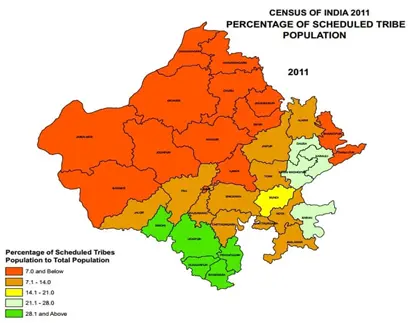
U.N. Economic and Social Council (ECOSOC):
- About:
- Established by the UN Charter in 1945, ECOSOC is one of the six principal organs of the United Nations.
- It is responsible for directing and coordinating economic, social, humanitarian, and cultural activities carried out by the UN.
- Decisions are made by a simple majority vote, with the presidency changing annually.
- Members:
- ECOSOC comprises 54 members elected for three-year terms by the General Assembly.
- Four of the five permanent members of the Security Council are continuously re-elected due to their significant funding contributions to ECOSOC’s budget, the largest of any UN subsidiary body.
- Functions:
- Coordinates the social and economic fields of the organisation, including 15 specialised agencies, five regional commissions, and eight functional commissions.
- Serves as a central forum for discussing international social and economic issues and formulating policy recommendations for member states and the UN system.
Role of Rajasthan's Tribal Communities in Tackling Global Challenges:
- Background:
- The HLPF on Sustainable Development was held at the UN headquarters in New York, established by the outcome of the UN Conference on Sustainable Development (Rio+20) in 2012.
- It is the central platform for the follow-up and review of the 2030 Agenda for Sustainable Development and the SDGs.
- Theme:
- "Reinforcing the 2030 agenda and eradicating poverty in times of multiple crises: The effective delivery of sustainable, resilient, and innovative solutions."
- A ministerial declaration adopted at the forum called for renewed efforts to achieve the SDGs and acknowledged the role of indigenous communities in biodiversity and ecosystem solutions.
Contributions of Rajasthan's Tribal Communities:
- Indigenous practices rooted in reverence for nature and community-centric approaches promote sustainability and resilience, essential for reinforcing the 2030 agenda amid crisis.
- Indigenous solutions meet their needs and contribute to broader sustainability goals.
- Events in southern Rajasthan focused on preserving indigenous seed varieties to link crop diversity with climate resilience.
- The forum emphasised that global crises, including climate change and socio-economic issues, exacerbate challenges like economic inequality and environmental degradation.
- Rajasthan’s tribal communities have adopted innovative approaches guided by sustainable and resilient solutions across environmental, social, cultural, and economic systems.
- Practices based on principles of swaraj (sovereignty) have led to self-sufficiency, reduced external dependence, and improved agricultural practices.
- Initiatives in seed sovereignty, soil sovereignty, food and nutrition sovereignty, water sovereignty, and cultural sovereignty have empowered tribal communities to overcome critical challenges collectively.
Best Practices Highlighted:
- Production of local seeds
- Water conservation at the source
- Use of animals in agriculture
- Checking soil erosion through mixed cropping
- Use of uncultivated food for nutritional security
- These practices have helped tribal communities reduce market dependence and survive difficult phases, including the COVID-19 pandemic in 2020-21
Source: TH
National Mission on Cultural Mapping (NMCM)
Why in the news?
- On July 23, 2024, a PIB press release stated that the government, under the National Mission on Cultural Mapping (NMCM), has taken an initiative to provide a comprehensive overview of the cultural heritage of 6.5 lakh villages across India.

About NMCM:
- Administering Body:
- The scheme is administered by the Ministry of Culture, Government of India.
- Conceptualization:
- NMCM was conceptualised to develop a comprehensive database of artists, art forms, and other cultural resources.
- These resources are gathered from cultural organisations in the Ministry of Culture, other ministries, and states, and are compiled on a robust IT-enabled platform.
Aims and Objectives:
- Awareness Creation:
- To create awareness about the strengths of cultural heritage and its interface with development and cultural identity.
- Cultural Mapping:
- To map 6.5 lakh villages along with their geographical, demographic profiles, and creative capitals.
- National Registers:
- To create National Registers of Artists and Art practices.
- Development of Digital Platforms:
- To develop a web portal and mobile app to function as a National Cultural WorkPlace (NCWP).
Coverage:
- The project aims to cover all inhabited villages in India as marked in the Census List, 2011, published by the Registrar General and Census Commissioner of India.
Database Access:
- The database can be accessed through the Mera Gaon Meri Dharohar Web Portal (mgmd.gov.in).
Usage:
- The database can be effectively used by any government ministry or other government organisation to safeguard and promote the cultures, traditions, art forms, and other cultural identities of the identified villages.
Source: PIB
PM Surya Ghar Muft Bijli Yojana
Why in the news?
- Recently, the government has issued operational guidelines for the implementation of incentives to DISCOMs under the PM-Surya Ghar-Muft Bijli Yojana.
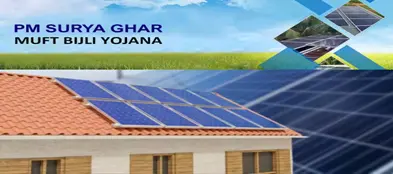
About PM Surya Ghar Muft Bijli Yojana:
- Scheme Launch: Introduced on February 15, 2024, the PM Surya Ghar Muft Bijli Yojana aims to provide free electricity to households in India.
- Subsidy Provision: Households will receive a subsidy to install solar panels on their roofs, covering up to 40% of the solar panel costs.
- Beneficiary Target: The scheme is projected to benefit 1 crore households across the nation.
- Government Savings: It is estimated to save the government Rs. 75,000 crores annually in electricity costs.
- Financial Outlay: The scheme has a total financial outlay of Rs 75,021 crore and is scheduled for implementation until FY 2026-27.
Eligibility Criteria:
- Citizenship: The household must be an Indian citizen.
- Property Ownership: The household must own a house with a roof suitable for installing solar panels.
- Electricity Connection: The household must have a valid electricity connection.
- No Previous Subsidy: The household must not have availed any other subsidy for solar panels.
Role of DISCOMs:
- State Implementation Agencies (SIAs): DISCOMs are designated as SIAs responsible for various facilitation measures, including ensuring the availability of net metres, conducting timely inspections, and commissioning installations.
- Incentive Mechanism: DISCOMs will receive incentives based on their performance in installing additional grid-connected rooftop solar capacity beyond a predefined baseline level.
- Financial Allocation for Incentives: The total financial outlay for the 'Incentives to DISCOMs' component is Rs 4,950 crore.
Source: AIR
MSME TEAM Initiative
Why in the news?
- Recently, under the Central Sector Scheme “Raising and Accelerating MSME Performance (RAMP)”, the Ministry of MSME launched “MSME Trade Enablement and Marketing Initiative” (MSME-TEAM Initiative).
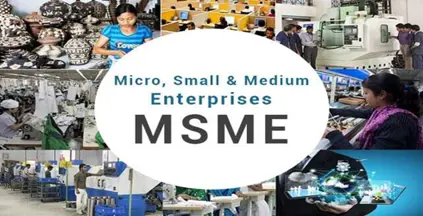
About MSME-TEAM Initiative:
- Purpose: The MSME-TEAM Initiative is designed to support 5 lakh Micro, Small, and Medium Enterprises (MSMEs) in joining the Open Network Digital Commerce (ONDC) platform by conducting awareness workshops that include hands-on assistance for onboarding.
- Financial Assistance: This initiative aims to provide financial aid to Micro and Small Enterprises (MSEs) via Seller Network Participants for activities like catalogue preparation, account management, logistics, packaging material, and design.
- Focus on Women-Owned MSEs: Out of the total 5 lakh MSEs to be supported, 2.5 lakh will be women-owned enterprises.
- Geographical Outreach: While the initiative targets MSEs across the country, awareness workshops will be prioritised in Tier 2 and Tier 3 cities and MSME clusters to ensure extensive reach, particularly among women and SC/ST-owned MSMEs.
- Duration: As a sub-scheme, the MSME-TEAM Initiative will be active for three years, up to March 2027, although MSMEs can continue to onboard ONDC beyond this period.
Key Facts about RAMP Scheme:
- Assistance and Launch: The RAMP scheme is supported by the World Bank and was launched by the Ministry of MSME on July 30, 2022.
- Objectives:
- Enhance market and credit access for MSMEs.
- Strengthen institutions and governance at central and state levels.
- Improve center-state linkages and partnerships.
- Address delayed payment issues.
- Promote the greening of MSMEs.
- National MSME Council: The Ministry has established the National MSME Council to act as an administrative and functional body for the RAMP Programme.
Sub-Schemes under RAMP:
- MSME GIFT Scheme: The MSME Green Investment and Financing for Transformation Scheme aims to help MSMEs adopt green technologies with interest subvention and credit guarantee support.
- MSE SPICE Scheme: The MSE Scheme for Promotion and Investment in Circular Economy supports circular economy projects through credit subsidy, aiming to achieve zero emissions by 2070.
- MSE ODR Scheme: The MSE Scheme on Online Dispute Resolution for Delayed Payments combines legal support with modern IT tools and Artificial Intelligence to address delayed payment issues for Micro and Small Enterprises.
What is ONDC?
- Network Design: ONDC is based on open protocols that enable local commerce across various segments like mobility, grocery, food delivery, hotel booking, and travel to be discovered and engaged by any network-enabled application.
- Interoperability: ONDC consists of protocols and specifications that allow different e-commerce platforms to connect and interoperate.
- Objectives: The platform aims to create new opportunities, curb digital monopolies, and support MSMEs and small traders by helping them get online.
- DPIIT Initiative: ONDC is an initiative by the Department for Promotion of Industry and Internal Trade (DPIIT) under the Ministry of Commerce and Industry.
- Democratisation of E-Commerce: ONDC seeks to move from a platform-centric model to an open-network, enabling sellers and buyers to transact digitally regardless of the platform or application used.
- Data Utilisation: Through ONDC, merchants can save their data to build credit history and reach consumers.
Source: PIB
Streptococcus thermophilus
Why in the news?
- Recently, Scientists at the Agharkar Research Institute (ARI) in India discovered a new strain of lactic acid bacteria while investigating the genetic makeup of a different strain of S. thermophilus.
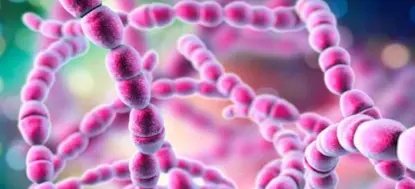
About the S. thermophilus:
- Characteristics:
- Gram-positive, non-motile, and non-sporulating bacteria.
- Capable of growing under both aerobic and anaerobic conditions.
- Role as a Probiotic:
- Found in the digestive tract as a beneficial bacterium.
- Produces lactic acid by converting lactose into lactic acid.
- Assists in food breakdown, nutrient absorption, and combating harmful organisms.
- Health Benefits:
- Enhances lactose digestion for lactose-intolerant individuals.
- Exhibits anti-inflammatory properties, potentially lowering the risk of inflammatory bowel disease.
- Applications:
- Widely used in the production of fermented dairy products like yogurt.
- Incorporated in probiotic supplements for its health benefits.
Discovery of MCC0200:
- New Strain:
- A new strain of lactic acid bacteria discovered by scientists at the Agharkar Research Institute (ARI) in India.
- Characteristics and Benefits:
- Thrives in the gut and adheres strongly to intestinal surfaces.
- Promotes gut health and immune function through mucosal surface adhesion.
- Possesses antioxidant properties that mitigate oxidative stress.
- Can assimilate cholesterol, potentially lowering serum cholesterol levels and reducing cardiovascular disease risk.
- Applications:
- Shows promise as a probiotic candidate for use in food and pharmaceutical products due to its health-promoting properties
Source: PIB
Economic Survey 2024
Context:
- The Economic Survey 2024, released on July 22, 2024, provides a detailed review of India's economic performance, projecting a 6.5-7% GDP growth for FY25, and highlights key sectors like agriculture, industry, and services.
- This year, the Economic Survey 2023–24 and the Union Budget 2024 have been delayed due to the general election, as presented by the Chief Economic Adviser, V. Anantha Nageswaran.
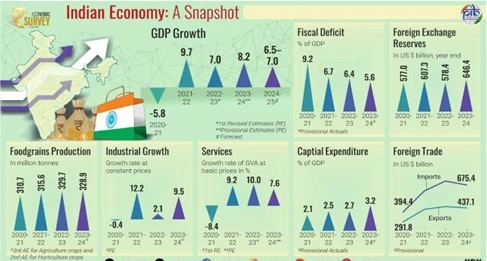
State of the Economy – Steady as She Goes
- The Economic Survey conservatively projects a real GDP growth of 6.5–7 per cent, with risks evenly balanced, cognizant of the fact that the market expectations are on the higher side.
- India's real GDP grew by 8.2 per cent in FY24, exceeding the 8 per cent mark in three out of four quarters of FY24.
- On the supply side, Gross value added (GVA) grew by 7.2 per cent in FY24 (at 2011-12 prices) and net taxes at constant prices grew by 19.1 per cent in FY24.
- With deft management of administrative and monetary policies, retail inflation reduced from 6.7 per cent in FY23 to 5.4 per cent in FY24.
- Current Account Deficit (CAD) stood at 0.7 per cent of the GDP during FY24, an improvement from the deficit of 2.0 percent of GDP in FY23.
- The Indian economy has recovered and expanded in an orderly fashion post pandemic. The real GDP in FY24 was 20 percent higher than its level in FY20, a feat that only a very few major economies achieved.
- 55% of tax collected accrued from direct taxes and remaining 45% from indirect taxes.
- Government has been able to ensure free food grains to 81.4 Crore people. Total expenditure allotted to capital spending has progressively enhanced.
Monetary Management and Financial Intermediation- Stability is the Watchword
- The Monetary Policy committee (MPC) maintained the status quo on the policy repo rate at 6.5 per cent in FY24. Inflation was made to gradually align with its target while supporting growth.
- Credit disbursal by Scheduled Commercial Banks (SCBs) stood at ₹164.3 lakh crore, growing by 20.2 per cent at the end of March 2024.
- Growth in broad money (M3), excluding the impact of merger of HDFC with HDFC Bank, was 11.2 per cent (YoY) as on 22 March 2024, compared to 9 per cent a year ago.
- Double-digit and broad-based growth in bank credit, gross and net non-performing assets at multi-year lows, and improvement in bank asset quality highlight the government’s commitment to a healthy and stable banking sector.
- Agriculture and allied activities witnessed double digits growth in credit during FY24.
- Industrial credit growth was 8.5 per cent compared to 5.2 per cent a year ago.
- IBC has been recognised as an effective solution for the twin balance sheet problem, in the last 8 years, 31,394 corporate debtors involving a value of Rs 13.9 Lakh Crore have been disposed off as of March 2024.
- Primary capital markets facilitated capital formation of ₹10.9 lakh crore during FY24 (approximately 29 per cent of the gross fixed capital formation of private and public corporates during FY23).
- The Indian microfinance sector emerges as the second largest in the world after China.
Prices and Inflation- Under Control
- Central Government’s timely policy interventions and the Reserve Bank of India’s price stability measures helped maintain retail inflation at 5.4 per cent - the lowest level since the pandemic.
- The Central Government announced price cuts for LPG, petrol, and diesel. As a result, retail fuel inflation stays low in FY24.
- In August 2023, the price of domestic LPG cylinders was reduced by ₹200 per cylinder across all markets in India. Since then, LPG inflation has been in the deflationary zone.
- Further, Centre lowered the prices of petrol and diesel by ₹2 per litre. Consequently, retail inflation in petrol and diesel used in vehicles also moved to the deflationary zone.
- Core services inflation eased to a nine-year low in FY24; at the same time, core goods inflation also declined to a four-year low.
- Food inflation stood at 6.6 per cent in FY23 and increased to 7.5 per cent in FY24.
- Government took appropriate administrative actions, including dynamic stock management, open market operations, subsidised provision of essential food items and trade policy measures, which helped to mitigate food inflation.
- 29 States and Union Territories recorded inflation below 6 per cent in FY24.
- Going forward, the RBI projects inflation to fall to 4.5 per cent in FY25 and 4.1 per cent in FY26, assuming normal monsoon and no external or policy shocks.
- IMF forecasts inflation of 4.6 per cent in 2024 and 4.2 per cent in 2025 for India.
External Sector - Stability Amid Plenty
- India’s rank in the World Bank’s Logistics Performance Index improved by six places, from 44th in 2018 to 38th in 2023, out of 139 countries.
- The moderation in merchandise imports and rising services exports have improved India’s current account deficit which narrowed 0.7 per cent in FY24.
- India is gaining market share in global exports of goods and services. Its share in global goods exports was 1.8 per cent in FY24, against an average of 1.7 per cent during FY16-FY20.
- India’s services exports grew by 4.9 per cent to USD 341.1 billion in FY24, with growth largely driven by IT/software services and ‘other’ business services.
- India is the top remittance recipient country globally, with remittances reaching a milestone of USD 120 billion in 2023.
- India’s external debt has been sustainable over the years, with the external debt to GDP ratio standing at 18.7 per cent at the end of March 2024.
Medium-Term Outlook – A Growth Strategy for New India
- Key areas of policy focus in the short to medium term - job and skill creation, tapping the full potential of the agriculture sector, addressing MSME bottlenecks, managing India’s green transition, deftly dealing with the Chinese conundrum, deepening the corporate bond market, tackling inequality and improving our young population’s quality of health.
- Amrit Kaal’s growth strategy is based on six key areas - boosting private investment, expansion of MSMEs, agriculture as growth engine, financing green transition, bridging education-employment gap, and building capacity of States.
- For the Indian economy to grow at 7 per cent plus, a tripartite compact between the Union Government, State Governments and the private sector is required.
Climate Change and Energy Transition: Dealing with Trade-Offs
- A report by the International Finance Corporation recognises India’s efforts to achieve committed climate actions, highlighting that it is the only G20 nation in line with 2-degree centigrade warming.
- As of 31 May 2024, the share of non-fossil sources in the installed electricity generation capacity has reached 45.4 per cent.
- Further, the country has reduced the emission intensity of its GDP from 2005 levels by 33 per cent in 2019.
- India’s GDP between 2005 and 2019 has grown with a Compound Annual Growth Rate (CAGR) of about 7 per cent, whereas the emissions grew at a CAGR of about 4 per cent.
- Total annual energy savings of 51 million tonnes of oil equivalent translates to a total annual cost savings of ₹1,94,320 Crore and emissions reduction of around 306 million tonnes.
- Expanding renewable energy and clean fuels will increase demand for land and water.
- Government issued sovereign green bonds amounting to ₹16,000 Crore in January-February 2023 followed by ₹20,000 Crore in October-December 2023.
Social Sector - Benefits that Empower
- Between FY18 and FY24, nominal GDP has grown at a CAGR of around 9.5 per cent while the welfare expenditure has grown at a CAGR of 12.8 per cent.
- Gini coefficient, an indicator of inequality, has declined from 0.283 to 0.266 for the rural sector and from 0.363 to 0.314 for the urban sector of the country.
- More than 34.7 crore Ayushman Bharat cards have been generated, and the scheme has covered 7.37 crore hospital admissions.
- The challenge of ensuring mental health is intrinsically and economically valuable. 22 mental disorders are covered under the Ayushman Bharat – PMJAY health insurance.
- ‘Poshan Bhi Padhai Bhi’ programme for early childhood education aims to develop the world’s largest, universal, high-quality preschool network at Anganwadi Centres.
- Vidyanjali initiative played a crucial role in enhancing educational experiences of over 1.44 cr. students facilitating community engagement and through volunteer contributions.
- The rise in enrolment in higher education has been driven by underprivileged sections such as SC, ST and OBC, with a faster growth in female enrolment across sections, witnessing 31.6 per cent increase since FY15.
- India is making rapid progress in R&D, with nearly one lakh patents granted in FY24, compared to less than 25,000 patent grants in FY20.
- Government provisioned ₹ 3.10 lakh crore in FY25; this shows a 218.8 per cent increase over FY14 (BE).
- Under PM-AWAS-Gramin, 2.63 crore houses were constructed for the poor in the last nine years (as of 10 July 2024).
- 15.14 lakh km of road construction has been completed under Gram Sadak Yojana since 2014-15 (as of 10 July 2024).
Employment and Skill Development: Towards Quality
- Indian labour market indicators have improved in the last six years, with the unemployment rate declining to 3.2 percent in 2022-23.
- The quarterly urban unemployment rate for people aged 15 years and above declined to 6.7 percent in the quarter ending March 2024 from 6.8 per cent in the corresponding quarter of the previous year.
- According to PLFS, more than 45 per cent of the workforce is employed in agriculture, 11.4 percent in manufacturing, 28.9 percent in services, and 13.0 percent in construction.
- According to PLFS, youth (age 15-29 years) unemployment rate has declined from 17.8 per cent in 2017-18 to 10 per cent in 2022-23.
- Nearly two-thirds of the new subscribers in the EPFO payroll have been from the 18-28 years band.
- From the gender perspective, the female labour force participation rate (FLFPR) has been rising for six years.
- As per ASI 2021-22, employment in the organised manufacturing sector recovered to above the pre pandemic level, with the employment per factory continuing its pre-pandemic rise.
- During FY15-FY22, the wages per worker in rural areas grew at 6.9 per cent CAGR vis-à-vis a corresponding 6.1 per cent CAGR in urban areas.
- Number of factories employing more than 100 workers saw 11.8 per cent growth over FY18 to FY22.
- Employment has been rising in bigger factories (employing more than 100 workers) than in smaller ones, suggesting a scaling up of manufacturing units.
- The yearly net payroll additions to the EPFO more than doubled from 61.1 lakh in FY19 to 131.5 lakh in FY24.
- The EPFO membership numbers grew by an impressive 8.4 per cent CAGR between FY15 and FY24.
- Manufacturing sector is less exposed to AI as industrial robots are neither as nimble nor as cost-effective as human labour.
- The gig workforce is expected to expand to 2.35 crore by 2029–30.
- The Indian economy needs to generate an average of nearly 78.5 lakh jobs annually until 2030 in the non-farm sector to cater to the rising workforce.
- Compared to 50.7 crore persons in 2022, the country would need to care for 64.7 crore persons in 2050.
- Direct public investment equivalent to 2 percent of GDP has the potential to generate 11 million jobs, nearly 70 percent of which will go to women.
Agriculture and Food Management – Plenty of Upside Left If We Get It Right
- Agriculture and allied sectors registered an average annual growth rate of 4.18 per cent at constant prices over the last five years.
- The allied sectors of Indian agriculture are steadily emerging as robust growth centres and promising sources for improving farm incomes.
- As of 31 January 2024, the total credit disbursed to agriculture amounted to ₹ 22.84 lakh Crore.
- As of January 31, 2024, banks issued 7.5 crores Kisan Credit Card (KCC) with a limit of ₹9.4 lakh crores.
- An area of 90.0 lakh hectares has been covered under micro irrigation in the country under the Per drop more crop (PDMC) from 2015-16 to 2023-24.
- It is estimated that for every rupee invested in agricultural research (including education), there is a payoff of ₹ 13.85.
Industry - Small and Medium Matters
- Economic growth of 8.2 per cent in FY24 was supported by an industrial growth rate of 9.5 per cent.
- Despite disruptions on many fronts, the manufacturing sector achieved an average annual growth rate of 5.2 per cent in the last decade with the major growth drivers being chemicals, wood products and furniture, transport equipment, pharmaceuticals, machinery, and equipment.
- Accelerated Coal production over the past five years has helped in reducing import dependence.
- India’s pharmaceutical market stands as the world's third largest by volume with the valuation of USD 50 billion.
- India is the world's second-largest clothing manufacturer and one of the top five exporting nations.
- India's electronics manufacturing sector accounts for an estimated 3.7 per cent of the global market share in FY22.
- PLI schemes attracted over ₹1.28 Lakh Crore of investment until May 2024, which has led to production/sales of ₹10.8 Lakh Crore and employment generation (direct & indirect) of over ₹8.5 Lakh.
- Industry must take the lead in incentivising R&D and innovation and improving the skill levels of the workforce by forging active collaboration with academia.
Services - Fuelling Growth Opportunities
- Services sector contribution to the overall Gross Value Added (GVA) has now reached the level prior to pandemic i.e. about 55%.
- The services sector has the highest number of active companies (65 per cent). A total number of 16,91,495 active companies exist in India as of 31 March 2024.
- Globally, India’s services exports constituted 4.4 per cent of the world's commercial services exports in 2022.
- Computer services and business services exports accounted for about 73 per cent of India’s services exports and witnessed a 9.6 per cent growth YoY in FY24.
- India's share in digitally delivered services exports globally increased to 6.0 per cent in 2023 from 4.4 per cent in 2019.
- The aviation sector in India has grown substantially, with a 15 per cent YoY increase in total air passengers handled at Indian airports in FY24.
- Air cargo handled at Indian airports increased by 7 per cent YoY to 33.7 lakh tonnes in FY24.
- FY24 ended with an outstanding services sector credit of ₹45.9 lakh crore in March 2024, with a YoY growth of 22.9 per cent.
- Passenger traffic originating in Indian Railways increased by about 5.2 per cent in FY24 compared to the previous year.
- Revenue-earning freight in FY24 (excluding Konkan Railway Corporation Limited) witnessed an increase of 5.3 per cent in FY24 over the previous year.
- Tourism industry witnessed over 92 lakh foreign tourist arrivals in 2023, implying a YoY increase of 43.5 per cent.
- In 2023, residential real estate sales in India were at their highest since 2013, witnessing a 33 per cent YoY growth, with a total sale of 4.1 lakh units in the top eight cities.
- Global Capability Centres (GCCs) in India have grown significantly, from over 1,000 centres in FY15 to more than 1,580 centres by FY23.
- The Indian e-commerce industry is expected to cross USD 350 billion by 2030.
- The overall tele-density (number of telephones per 100 population) in India increased from 75.2 per cent in March 2014 to 85.7 per cent in March 2024. The internet density also increased to 68.2 per cent in March 2024.
- As of 31 March 2024, 6,83,175 kilometres of Optical Fibre Cable (OFC) has been laid, connecting a total of 2,06,709 Gram Panchayats (GPs) by OFC in the BharatNet phase I & II.
Infrastructure – Lifting Potential Growth
- Buoyant public sector investment has had a pivotal role in funding large-scale infrastructure projects in recent years.
- The average pace of NH construction increased by nearly 3 times from 11.7 km per day in FY14 to around 34 km per day by FY24.
- Capital expenditure on Railways has increased by 77 percent in the past 5 years, with significant investments in the construction of new lines, gauge conversion and doubling.
- Indian Railways to introduce Vande metro transit coaches in FY 25.
- In FY24, new terminal buildings at 21 airports have been operationalised which has led to an overall increase in passenger handling capacity by approximately 62 million passengers per annum.
- India’s rank in the International Shipments category in the World Bank Logistics Performance Index has improved to 22nd in 2023 from 44th in 2014.
- The clean energy sector in India saw new investment of ₹8.5 lakh crore (USD 102.4 billion) between 2014 and 2023.
Climate Change and India:
- The Western approach does not seek to address the root of the problem, i.e. overconsumption, but rather chooses to substitute the means to achieve overconsumption.
- A one-size-fits-all approach will not work, and developing countries need to be free to choose their own pathways.
- “Mission LiFE” focuses on human-nature harmony promoting mindful consumption rather than over consumption that lies at the root of the global climate change problem.
Conclusion
The Economic Survey 2023-24 highlights India's robust economic performance and strategic focus on growth, stability, and sustainability. Government policies aim to maintain this positive trajectory, address challenges, and seize opportunities for continued development. Analysing the survey provides insights into the country's economic path and necessary policy measures for sustainable growth.
Source: PIB
Share the article
Edukemy’s Current Affairs Quiz is published with multiple choice questions for UPSC exams
MCQ
Get Latest Updates on Offers, Event dates, and free Mentorship sessions.

Get in touch with our Expert Academic Counsellors 👋
FAQs
UPSC Daily Current Affairs focuses on learning current events on a daily basis. An aspirant needs to study regular and updated information about current events, news, and relevant topics that are important for UPSC aspirants. It covers national and international affairs, government policies, socio-economic issues, science and technology advancements, and more.
UPSC Daily Current Affairs provides aspirants with a concise and comprehensive overview of the latest happenings and developments across various fields. It helps aspirants stay updated with current affairs and provides them with valuable insights and analysis, which are essential for answering questions in the UPSC examinations. It enhances their knowledge, analytical skills, and ability to connect current affairs with the UPSC syllabus.
UPSC Daily Current Affairs covers a wide range of topics, including politics, economics, science and technology, environment, social issues, governance, international relations, and more. It offers news summaries, in-depth analyses, editorials, opinion pieces, and relevant study materials. It also provides practice questions and quizzes to help aspirants test their understanding of current affairs.
Edukemy's UPSC Daily Current Affairs can be accessed through:
- UPSC Daily Current Affairs can be accessed through Current Affairs tab at the top of the Main Page of Edukemy.
- Edukemy Mobile app: The Daily Current Affairs can also be access through Edukemy Mobile App.
- Social media: Follow Edukemy’s official social media accounts or pages that provide UPSC Daily Current Affairs updates, including Facebook, Twitter, or Telegram channels.


